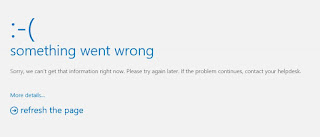Exchange 2013 OWA Something Went Wrong
While I know Exchange 2016 has been released, some of you may have just succeeded in your year long badgering campaign to convince the higher ups to move to Exchange 2013 and get off of Exchange 2007, 2010, or God forbid Exchange 2003. If it's the latter, then you have my heart felt sympathies - both because you were stuck on that for all this time and for the amount of work your gonna need to do to get to Exchange 2013
Well, assuming you were persuasive enough and they did in fact agree to let you go to 2013, this post might be of help. As all good little admins should, I built a dev environment and ran through the upgrade process. I fine tuned the steps as I went and got my list down. Confidence was brimming. Servers were created, storage provisioned, and change controls logged. With a quiet anticipation I started the install. Everything went by the book. My list hadn't failed me......until I logged into OWA. I was met with a sad face staring back at me from my browser with the oh so helpful wording something went wrong. I tried the ECP site and that also gave me the finger.
Much Google searching ensued, eventually ending up with a call to Microsoft support, which then had to get escalated before we got it resolved.
Turns out this is one of those pay me bitches error messages. By which, I mean it's a generic error message meaning any number of issues that inevitably involve a call to the vendors support line and possibly a charge if you didn't buy support. It also allows the vendor to send you a yearly bill for the support renewal. From the posts I read through, it generally seems to be caused by a failure of Exchange 2013 to proxy through to Exchange 2010 to get mailbox data.
The below steps are based on moving from Exchange 2010 to Exchange 2013. They may work for 2007 as well but it's not something I did.
First thing to try is modifying the url you're using to get to the site. If you're using https://myserver/ecp try changing this to https://myserver/ecp/?ExchClientVer=15.
Next, take a look at the user account you're trying to log in with Log into AD users and computers, find the user. Look at the properties of their account and make sure inheritable permissions in on.
Third on the list is make sure you run through the Exchange Server Deployment Assisstant. This little fella will take you through all the steps needed to migrate from an older version to a new version. It will give you all the PowerShell commands needed to make proxying work.
The final thing to check - and this is what I had to do to get it working - is the Internal Authentication Methods on the 2010 CAS servers. To check this, do the following from an Exchange PowerShell console:
Well, assuming you were persuasive enough and they did in fact agree to let you go to 2013, this post might be of help. As all good little admins should, I built a dev environment and ran through the upgrade process. I fine tuned the steps as I went and got my list down. Confidence was brimming. Servers were created, storage provisioned, and change controls logged. With a quiet anticipation I started the install. Everything went by the book. My list hadn't failed me......until I logged into OWA. I was met with a sad face staring back at me from my browser with the oh so helpful wording something went wrong. I tried the ECP site and that also gave me the finger.
Much Google searching ensued, eventually ending up with a call to Microsoft support, which then had to get escalated before we got it resolved.
Turns out this is one of those pay me bitches error messages. By which, I mean it's a generic error message meaning any number of issues that inevitably involve a call to the vendors support line and possibly a charge if you didn't buy support. It also allows the vendor to send you a yearly bill for the support renewal. From the posts I read through, it generally seems to be caused by a failure of Exchange 2013 to proxy through to Exchange 2010 to get mailbox data.
The below steps are based on moving from Exchange 2010 to Exchange 2013. They may work for 2007 as well but it's not something I did.
First thing to try is modifying the url you're using to get to the site. If you're using https://myserver/ecp try changing this to https://myserver/ecp/?ExchClientVer=15.
Next, take a look at the user account you're trying to log in with Log into AD users and computers, find the user. Look at the properties of their account and make sure inheritable permissions in on.
Third on the list is make sure you run through the Exchange Server Deployment Assisstant. This little fella will take you through all the steps needed to migrate from an older version to a new version. It will give you all the PowerShell commands needed to make proxying work.
The final thing to check - and this is what I had to do to get it working - is the Internal Authentication Methods on the 2010 CAS servers. To check this, do the following from an Exchange PowerShell console:
- Get-OwaVirtualDirectory "myserver\owa (Default Web Site)" | select *authentication*
- Check the InternalAuthenticationMethods. It should contain WindowsIntegrated
- If it doesn't check WindowsAuthentication is set to True.
- If it's set to True disable and enable again.
- Set-OwaVirtualDirectory "myserver\owa (Default Web Site)" -WindowsAuthentication:$False
- Set-OwaVirtualDirectory "myserver\owa (Defailt Web Site)" -WindowsAuthentication:$True
- If it's set to False enable it.
- Run the first command again and check the InternalAuthenicationMethods. WindowsIntegrated should be listed now.





Comments
Post a Comment